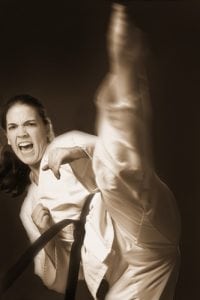Marketing in the martial arts industry poses some particular challenges. Unless your studio is located in a small town, the chances are good that you have significant competition from other studios and dojos in your area. That means that in order to attract new students and grow your business, you have to find a way to stand out from the competition.
Logo Design for Martial Arts
The first element of branding to consider is your logo. The martial arts logo you choose should be simple and memorable, offering a clear indication of your industry without lapsing into cliché. Let’s talk about the key elements of logo design.
Iconography and Martial Arts
The iconography you choose for your logo must give the people who see it a clear idea of what you do. Many martial arts companies choose images of martial artists to incorporate into their logo. You can do that too, but if you do, it’s important to find a way to make the iconography of your logo unique.
Some other options include the use of animals – many martial arts studios use images of dragons and tigers in their logos – or the use of Asian characters and symbols. Whatever you choose, make sure that it doesn’t copy what your competitors do.
Color Choices and Emotions
It’s very common for martial arts companies to choose the colors red and black for their logos. Red symbolizes excitement and passion, and that certainly makes it a fitting choice for martial arts. Red also has a special place in Asian culture. Black calls to mind black belts, a symbol of excellence.
However, it’s a good idea to consider alternatives. Other colors to consider include blue, which conveys calm and authority, and gold, which symbolizes excellence and achievement.
Typography
As mentioned above, the use of Chinese, Japanese, and Korean characters is common in the world of martial arts. Likewise, many companies choose typography that has a similar feel to it, particularly fonts that look like they were created by brushstrokes.
The fonts most commonly chosen are strong and bold. Sometimes, a martial arts company might pick a decorative script font, but for the most part you want your typography to be strong and authoritative.
Logo Analysis
Now let’s look at a logo that we designed to see how all the elements we have discussed might come together.

This logo uses black and gold, an unusual combination in the world of martial arts. The gold has a metallic gleam to it that indicates quality and excellence.
The image in the center of the logo is a stylized fist, something that immediately calls to mind the first of a martial artist as he breaks a board or a brick with his hand. It’s powerful and recognizable without being at all predictable or expected.
Additional iconography here includes stars, another symbol of excellence, and small images of martial artists underneath the first. It’s a memorable logo that manages to clearly identify itself without looking like other martial arts logos.
Tips for Creating a Memorable Martial Arts Brand
Creating a memorable martial arts brand starts with your logo, but it’s also important to think about how you represent your brand when you move beyond the simple visual elements of your logo.
Creating a Client/Student Persona
The first thing you can do to help define your brand is to create a persona of your ideal client or student. Many martial arts studios need to create more than one persona, particularly if they offer classes to both children and adults.
The persona you create should have as many qualities as possible that represent the people who are likely to come to your school. For example, if you are creating a parent persona, the persona might include information about the concerns that bring parents to martial arts and what they hope it will do for their children.
How to Position Yourself against Your Competition
The next step is to position yourself in the marketplace. Even if you have multiple competitors in your area, the chances are good that you differ from them in some way.

For example, perhaps other studios in your area offer kids’ classes, but you’re the only one who has an after school program. Or maybe you offer classes specifically designed to help kids overcome bullying. Whatever those things are, identifying them can help you stand out from your competitors.
Find Your Brand’s Voice
Finally, you need to identify a strong and consistent voice for your brand. The voice you use should speak directly to your target audience. You need to give thought to all of the following:
1. The tone you use. For example, many companies in the martial arts industry use a conversational tone, similar to the way you might talk to a friend or a family member.
2. The vocabulary you use. Since the bulk of your marketing is meant to appeal to people who are not yet clients, you probably want to avoid using jargon or unfamiliar words. Your vocabulary should be accessible to someone who knows little to nothing about martial arts.
3. The emotion behind your voice. For example, if you want to appeal to parents, you might use a warm tone designed to let them know that you care about them and their children.
Taking these three things into consideration can help you determine the right voice for your brand. Once you do, it is important to make sure that everybody who speaks and writes on behalf of your company uses the same voice.
Content Marketing Ideas for Martial Arts Companies
Content marketing is at the heart of many companies’ online marketing strategy – and it’s an ideal way for martial arts studios to attract new clients. Basically, it allows you to share valuable information with your target audience, and to help them see the benefits of studying martial arts.
The key to successful content marketing is to choose your content wisely. Some forms of content are more compelling than others.
Explainer Videos and Demos
The first type of content to consider is the explainer video or demonstration. These videos are what they sound like. They can be used to explain a product – in this case, martial arts – or to demonstrate something.
Martial arts companies can use videos to do things like:
1. Provide a tour of your studio and an explanation of what you do there.
2. Give an overview of your after school program, summer camp, or any other specialized programs you offer.
3. Demonstrate a particular move or series of moves.
You can do almost anything you like, but the key is to keep your focus on what your customers need from you, and use the video to give it to them.
Tips for Taking Great Pictures for Your Website or Social Media
The next thing to try is taking and sharing compelling and powerful photographs to demonstrate what you do. Visual content is the most popular form of online content and you should take advantage of that fact.
The key to taking great pictures is to use a good camera with high resolution, and make the pictures authentic. Using stock photos is a mistake when you’re selling martial arts because you want to give people an idea of what your school’s culture is.
You need good lighting (preferably natural light, but if not, white LED bulbs are best) and willing subjects. You might consider taking some candid shots during classes or, alternatively, asking particular students to model for you.

Try to shoot against the simplest background possible. You don’t want viewers’ eyes to be distracted by other things.
When you post images, share some information about where they came from. Give people a bit of a story to go with the images, and their impact will be amplified.
Blogging Tips
Finally, if you don’t already have a blog, like we have on your website, you should consider adding one. Blogging keeps your website up to date and gives potential clients a reason to keep coming back to it. Here are some tips for blogging:
1. Your blog posts don’t need to be long 400 to 600 words is ample.
2. Keep each post tightly focused on one topic – don’t try to do too much.
3. Your topics should be things that are valuable and relevant to your target audience.
4. Use short paragraphs and break up the text with images, subheadings, and videos.
5. End each post with a call to action and encourage people to leave comments by asking questions.
If you follow these steps, you’ll have an engaging and popular blog that helps you generate leads for your company. Check out the blog for The Logo Company
Conclusion
Marketing a martial arts company poses some special challenges. However, if you use the suggestions here, you’ll be sure to attract new leads and new clients – and help your company to grow.
